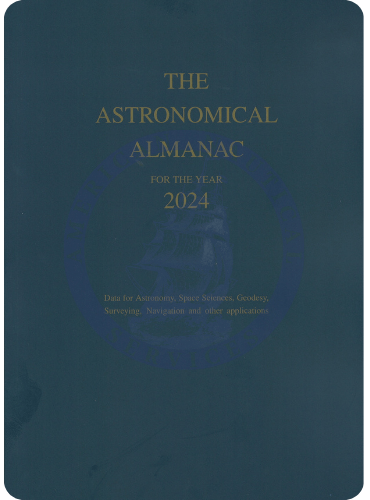








The Astronomical Almanac, 2024 Edition
- Precio
- $122.95
Retiro no disponible actualmente en 3311 S. Andrews Ave.
The Astronomical Almanac is a joint publication of the U.S. Nautical Almanac Office, United States Naval Observatory (USNO) in the United States, Her Majesty's Nautical Almanac Office (HMNAO), and the United Kingdom Hydrographic Office (UKHO). This annual publication contains precise ephemerides of the Sun, Moon, planets, and satellites; data for eclipses and other astronomical phenomena for a given year; and serves as a worldwide standard for such information.
BOOK IS NO LONGER AVAILABLE IN HARDCOVER
I have been using these Almanacs for more than 50 years, and it is the first book I reach for on the start of an observing run. I depend on their tables of Bright Stars, Cluster, and now Radio Sources. The new ICRS has the AA as a bedrock contributor and many of the people at USNO were involved in establishing the new standards. It’s all boiled down in the AA, and you really need a copy of the Explanatory Supplement to get the most out of the Almanac.
I worried when I didn’t see any publication for 2024 from the US Govt Printing Office. But then I read some scuttlebut on the internet and found you guys as the source of the 2024 Issue. Thanks for being there for me!
Have ordered The Astronomical Almanac for the Year XXXX since the mid-1970s. In the past have ordered from the U.S. Government Printing Office online bookstore. But availability notices did not appear in years 2022 and 2023 until the new year had already started. And no notice so far in 2024. So did a Google search and found American Nautical Services.
It is reassuring that the Astronomical Almanac looks the same as in the past. As always, the front matter of each section (Notes and formulas, etc.) is at a professional level of detail.
But I am worried. Not about the quality of the Astronomical Almanac. Rather about the future of this very important annual publication, when I had to do a Google search well into 2024, just to find a source for a copy of the Astronomical Almanac for the Year 2024.
The Astronomical Almanac for the year 2024 is the first edition based on JPL's newest Solar System integration "DE440",
and is the first one available only in paperback, which prevents it from being able to stay open on a table, and allows the cover and back to curl up at the edges over time. The pages are the same size, but thicker paper: the past Almanacs were 1.0 inch thick, this one is 1.4 inches thick. DE440 has improved over its predecessor DE430: for example: gravity wave measurements have most of the noise due to errors in Jupiter's position no longer present when using DE440 instead of DE430. The 2024 Almanac also has many of it's data tables updated. For example the table on Natural Satellites' Orbits and masses has mostly brand new data, Triton mass is 3.3x too small, because they divided by 428 instead of 1428. Unfortunately with all the updates throughout the book, many new typos appear throughout. For example the table for heliocentric coordinates of the Planets, and also the Keplerian Orbit elements table both start with the column heading "Julian Date (TDB) 245..." but those are all typos because JD2460000 has past.
The Astronomical Almanac for the Yesr 3024 arrived quickly im in g perfect condition. It’s apparently now sold only in paperback form. instead of hardcover like past years which was a surprise.
As always, American Nautical Services is excellent in carrying and quickly fulfilling my order. However, this year's 2024 Astronomical Almanac is so far only available in paperback, a first in the decades of my using it and my collection of them dating to 1935. This makes it less convenient to use (will not stay open on a desk or easily in the hand) and the spine will be less robust over frequent use. Not a good combination.
I have been using these Almanacs for more than 50 years, and it is the first book I reach for on the start of an observing run. I depend on their tables of Bright Stars, Cluster, and now Radio Sources. The new ICRS has the AA as a bedrock contributor and many of the people at USNO were involved in establishing the new standards. It’s all boiled down in the AA, and you really need a copy of the Explanatory Supplement to get the most out of the Almanac.
I worried when I didn’t see any publication for 2024 from the US Govt Printing Office. But then I read some scuttlebut on the internet and found you guys as the source of the 2024 Issue. Thanks for being there for me!
Have ordered The Astronomical Almanac for the Year XXXX since the mid-1970s. In the past have ordered from the U.S. Government Printing Office online bookstore. But availability notices did not appear in years 2022 and 2023 until the new year had already started. And no notice so far in 2024. So did a Google search and found American Nautical Services.
It is reassuring that the Astronomical Almanac looks the same as in the past. As always, the front matter of each section (Notes and formulas, etc.) is at a professional level of detail.
But I am worried. Not about the quality of the Astronomical Almanac. Rather about the future of this very important annual publication, when I had to do a Google search well into 2024, just to find a source for a copy of the Astronomical Almanac for the Year 2024.
The Astronomical Almanac for the year 2024 is the first edition based on JPL's newest Solar System integration "DE440",
and is the first one available only in paperback, which prevents it from being able to stay open on a table, and allows the cover and back to curl up at the edges over time. The pages are the same size, but thicker paper: the past Almanacs were 1.0 inch thick, this one is 1.4 inches thick. DE440 has improved over its predecessor DE430: for example: gravity wave measurements have most of the noise due to errors in Jupiter's position no longer present when using DE440 instead of DE430. The 2024 Almanac also has many of it's data tables updated. For example the table on Natural Satellites' Orbits and masses has mostly brand new data, Triton mass is 3.3x too small, because they divided by 428 instead of 1428. Unfortunately with all the updates throughout the book, many new typos appear throughout. For example the table for heliocentric coordinates of the Planets, and also the Keplerian Orbit elements table both start with the column heading "Julian Date (TDB) 245..." but those are all typos because JD2460000 has past.
The Astronomical Almanac for the Yesr 3024 arrived quickly im in g perfect condition. It’s apparently now sold only in paperback form. instead of hardcover like past years which was a surprise.
As always, American Nautical Services is excellent in carrying and quickly fulfilling my order. However, this year's 2024 Astronomical Almanac is so far only available in paperback, a first in the decades of my using it and my collection of them dating to 1935. This makes it less convenient to use (will not stay open on a desk or easily in the hand) and the spine will be less robust over frequent use. Not a good combination.






